
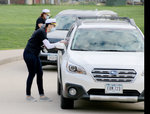


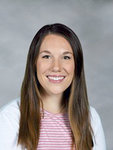
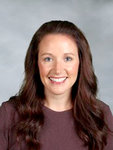
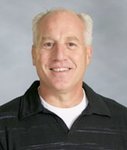

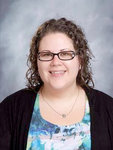
North Scott Community Schools’ mad dash to online education is built on a foundation of teacher collaboration and shared technology that, as it turns out, has been years in the making.
Teachers report vastly different experiences creating online-only experiences from lesson plans that relied on classroom interaction, but had more digital connections than had been apparent.
“We’re seeing benefits of incorporating technology, but we’re not forgetting that face-to-face is key,” high school principal Shane Knoche said.
Elementary teachers are sharing ungraded lessons and videos online and conducting weekly Zoom sessions, so students can see and hear one another.
High school teachers are completing the term pass-fail, setting standards that prepare students for the next level without overwhelming students and families already immersed in change.
And everyone is awash in emails, which typically are not students’ social medium of choice.
“Students are bad at emails,” said high school English teacher Jennifer Sambdman. “The first day we went live, I had a girl in tears. She had 87 brand new emails. I tried to calm her down, and calm her mom down, too.”
Emails, Google Meets and Docs are joining the district’s own online platform, Canvas, for students already equipped with thousands of Chromebooks that proved a godsend during this pandemic.
“We were blessed to have one-to-one access. As I talk to other principals across Iowa, that’s not always the case,” Knoche said.
For most students, education isn’t the only thing that’s changing. All are coping with uncertainty, like everyone else. Many are struggling to juggle all the new inputs, while missing the daily contact with friends and teachers.
Teachers find others preferring this topsy-turvy environment.
“I have a student with ADHD. It was pulling teeth to get him to produce during the school year. Now he’s burning land-speed records to get work to me. For some kids, the freedom of asynchronous learning changes everything. For some of these kids, I could say it almost has been a godsend.”
Chemistry teacher Kevin Tippet said, “Some kids feel more comfortable with this. They’re able to prioritize their days. They’re seeing they can do chemistry homework at 6 or 7 o’clock at night. I think there are advantages to that.”
Students are embracing flexibility, especially those clocking more hours on the job than ever before. “We’ve got kids we’re relying on at the grocery store to keep it open for our community. We have kids providing child care for their moms who are nurses,” Knoche said.
The district’s years of creating planned learning communities –teaching groups centered on grade levels and subject matters – laid the groundwork for collaboration that built online-only alternatives in less than one month.
All teachers interviewed for this story agreed that emphasizing personal connections is paramount for online lessons to succeed.
That hit home for Sambdman, who shared some students’ confessions. “I never imagined they would utter, ‘I just want to go back to school.’ They tell me, ‘I never thought I’d say it either, Sambdman.’”
The trial by fire forged a bond that may not compensate for classroom interaction, but will remain forever memorable.
“I’m very proud of the North Scott community, our students, teachers, leaders, tech support, custodians, food delivery service,” White Elementary reading interventionist Kaitlyn Lilly said. “I’m proud to say I’m a part of this district, for sure.”
Knoche said every day is a lesson for administrators, too. “If we have another spike, we need to be ready to go.”
Making connections
At 2 p.m. Fridays, Natalie Rogalski Vanderhard welcomes her Grissom Elementary class of 19 sixth-graders to a Zoom conference, where she’s ready with lessons and learning games.
“Usually they have questions mostly on how our school is looking,” she said.
Today, it’s looking empty as teachers collected their own belongings, then packaged their students’ materials last touched before spring break.
She contacts students and shares lessons through the week, and hosts Zoom office hours. Thanks to Central Scott Telephone, Verizon, and the district’s own hot spots, all 19 now have access.
Once they’re hooked up, the sixth-graders know what to do.
“Our students have so much experience with technology,” she said. Students have email and Google accounts to share work.
“For our kindergarten, first- and second-graders, they didn’t have email. They never used Google classroom. They had to virtually teach students and parents how to access.
“Fourth grade and up, we’ve done all these things before. It’s a huge hurdle we didn’t have to jump over.”
Most students are rapid adapters.
“The students grow so much, and they’re so independent. At the beginning of the school year, it takes 10 minutes for them to get going on a Chromebook. At the end of the year, it’s 10 seconds.”
The technology is just a different means to the same end.
“I feel like my job is to get them in deep with connections,” she said. “We check in with everything. I say hi to every student. How are you? What have you been up to? It gives them an opportunity to share how they’re feeling.
“Some are keeping real busy and excited. Others are bored.”
The interaction helps this teacher see other lessons brought about by the pandemic.
“You can see some students taking on more responsibilities at home. Doing new chores, gardening, older students helping younger siblings set up email and navigate their ways through this.”
Vanderhard is learning a bunch, too.
“The biggest thing I’ve taken away is how that connection with students puts me at ease. Knowing I can contact my students, hear back from them, hear them say, ‘I’m doing good.’ To see them smile, that has been huge.”
She’s not quite sure what to expect from next year’s sixth-graders. “Honestly, I think it depends on the kid. I think a lot of kids will be just fine. I think every teacher will move forward knowing they had a big gap. It’s just like every summer. Some students retain just fine.
“There is definitely stuff we won’t get to, just because we’re not instructing as much. We’re trying to keep it manageable for families. We’re focusing on what is most essential to keep learning, but not feeling overwhelmed.”
Missing faces
Kaitlyn Lilly partners with elementary classroom teachers to improve students’ comprehension and study habits.
That work had been very classroom dependent.
“A lot of the work I do assesses in the moment, what I see from the child. I’m getting kids to respond with their writing to give them an idea what expression looks like. The intervention comes seeing them face to face, looking at their eyes and seeing where their eyes are looking. That part is not there.
“The first week, I reached out to kids and made connections. I got into this profession for the relationships, and that’s where the best learning occurs. We do read-alouds and think-alouds,” where students learn to present ideas to others.
Accomplishing that online has been a struggle. But it also has brought some unexpected advantages.
“It gives a chance for maybe parents to help, or see what their child is doing. I also think just going at their own pace can be a help.”
Lilly reaches out occasionally with emails to parents. “Tell me a couple words the student had trouble with, or what words they did really well.”
This month’s writing lessons for fifth-graders focus on sensory details. “I will use an excerpt from a book, ‘Wild Mindfulness.’ I model the sensory details in this one.”
Lilly uploads excerpts to Google docs. Students key in comments acknowledging sensory details in the text. Next up: They write their own.
“The main thing it’s been cool to see is everyone just coming together. We’re all learning. Technology has been a learning curve for a lot of us. I’d never been a teacher on Google classroom.”
Video algebra
Eight years ago, math teacher Bryan Braack discovered blended learning.
That sparked his interest to earn certification for a form of online education that presents instruction for students online, and use classroom time for problem solving and discussion.
“I have videos of all my lessons, so my students are used to watching video and doing the homework. So that part’s not too much different,” Braack said.
Standing before his iPad, Braack uses the app, “Explain Everything.” They are posted on YouTube under his name. He also shares videos made by high school business teacher Ellen Oltman.
In his own videos, “I write out the problems and explain how to do them. I try not to make them more than 15 minutes. A majority of the kids like it. Some don’t. They say, ‘I’d rather have you explain it in class.’”
Braack has 105 Algebra II students, and about 50 others in his higher level accounting and Project Lead the Way programming courses.
His challenge has been replicating the classroom experience.
“I’m answering emails. Students have questions, like ‘How do you do this one? What did I do wrong? Can you show me?’ They work on problems throughout the week, then complete a quiz, or assessment to measure progress. A score of 60 percent or more passes.
“Some of the students prefer this, the ones that don’t want to answer in class thinking it might be a stupid question.”
Others value the classroom interaction.
“I think they might struggle a little bit that way. They like to hear me talk and in front of the room, so they can ask a question right away.”
His subject matter may be better suited to blended instruction. But he’s studied enough to find pertinence for almost every subject.
“It does fit a little bit better with science and math. But there are a lot of teachers out there adapting it to English, Spanish, or history,” as examples.
Next school year, Braack expects more catch-up work for students experiencing their longest break ever.
“We tried to get essential learning and essential standards we felt they needed for the rest of the year. There might be some remediation, just because we’re not getting through it all.”
Chem teacher gets schooled
High school chemistry teacher Kevin Tippet is working harder than ever transforming his classroom instruction into online videos and lessons.
“The perception a little bit is that school is out. For most teachers, this is more difficult. I’ve been putting in more hours trying to get lessons for my students.
“For me and other teachers, trying to move lessons to an online format has been a pretty big undertaking. I’m really proud of the teachers in my department. Our classes are going to count for kids.
“I’ve learned a tremendous amount — new technology, new ways of getting the information across. I’m finding myself more empathetic. They’re dealing with stuff we don’t know about. This is new for all of us; there’s a lot of anxiety out there.”
Tippet initiated his first online lab last week, posting a YouTube video about chemical reactions of baking soda with other elements.
“Certain areas might lend themselves better to online, like some of the direct instruction we do face to face. Demonstrating the skills with hands-on is the teacher role. I’m struggling with how do I give them that same experience.”
Students complete weekly assessments that evaluate comprehension of posted lessons. But classroom teachers rely on other ways to assess progress.
“My biggest fear now is not being able to see my students. When I walk around the classroom and question students, I can see how they respond, who is engaged, who gets it. Now, I’m not quite knowing how my students are doing outside of an assessment every week.”
His mostly sophomore and junior chemistry students seem to be adapting more quickly. He encountered no major access obstacles. In fact, some students improved study habits.
“One of my football players is working full time on a farm. He does most of his work at night. The discipline in class matters a little bit. A bigger factor now is the teacher’s comfort level with technology.”
Tippet is making more videos than he ever imagined.
And he’s got a good advisor. Son Kade is in his honors chemistry class, “so I’ve got a guinea pig.” That guinea pig caught an error in a lesson before Tippet posted it.
As a football coach, the online interaction has been more about team building and connectedness, than fitness and plays.
“We send notes out to kids. Some coaches have done Zoom meetings with kids,” he said. “A lot of it is just, ‘How are you doing? What are you up to?’ Not football stuff. We’re just trying to keep their connections up.”
He finds student athletes comfortable with – eager even – to keep fit.
“Coach Stewart uses a strength conditioning app. He sends out workouts twice a week, things they can do at home. The physical part is important. But keeping those relationships among the kids, let them know that we’re still here. I think the mental health part can be much more important.”
Come fall, he anticipates some students may need catch-up work, but said that's how every new school year begins.
"Teachers will have to take every student as they come. I expect when they come in that they have a certain level of skills. But others don’t have the same tools in their tool box. There might be more of that since we missed part of this quarter."
Finding structure
A month of online instruction convinced this composition, literature and honors English teacher the value of classroom structure.
More than half of her 114 students are in honors courses earning dual college credits and are self-starters.
“When all the kids started going online, my particular population is kids who get top grades. They felt overwhelmed. It created a lot of anxiety seeing the amount of work they were expected to accomplish in one week without the usual structure.
“I’m learning how much kids need structure. It’s hard for kids to engage, especially now that we’re pass-fail. There are studies that say grades don’t motivate. But with my group, it’s 100 percent of their motivation.
“The bell rings, they sit down and say, ‘I’m going to learn.’ Now these kids don’t have a change of scenery and physiological cues to balance things out. We can tell the kids to make a schedule all they want, and they can’t. They’re still kids. The structure of the school day is more important than I thought.”
Sambdman posts videos and schedules students in groups, or individually for Google Meets sessions.
“I load up my Wednesdays with my Google meets. On Mondays, Tuesdays, Thursday and Fridays, I schedule Google conferences.”
Finding that structure helped her immensely.
“I had a mental breakdown on the second Monday we went live,” she said. “I had 13 Google meets all in one day.”
That included department meetings, instructional coaching, building a leadership team. “It doesn’t sound like a lot when you’re sitting on the couch. But I realized I needed to settle myself better.”
Sambdman created her own structure. “Before this happened, I was one of those teachers working 12 hours a day. There was a blurry line between work and home. Now, I don’t work after 4 p.m., and only work one day on weekends.
“Teaching at home is a lot harder than teaching in the classroom. It’s easier to sit down next to a kid and work through something than waiting a couple of days, see if something gets turned in, then try to schedule a Google meet.”
Since the shutdown, she’s had two students in tears over break-ups. “When a kid is crying and upset, we’re there for that reassuring hug. I can’t make sure kids are OK mentally and physically as I can in the classroom.”
Sambdman resorts to Twitter occasionally to motivate students.
“I’ll blast out on Twitter and say, ‘Hey, @whatever, are you going to be moving on that essay?’”
More often, she’ll email “my picture glaring at you with my teacher look.”
Occasionally, she’ll follow up with parents.
“I had a freshman who didn’t turn in his essay. I sent a Canvas message and didn’t hear anything. So I sent it to him and his mom. Then I downloaded a Google voice app and called mom. She wasn’t checking email. She got on him and I got it.”